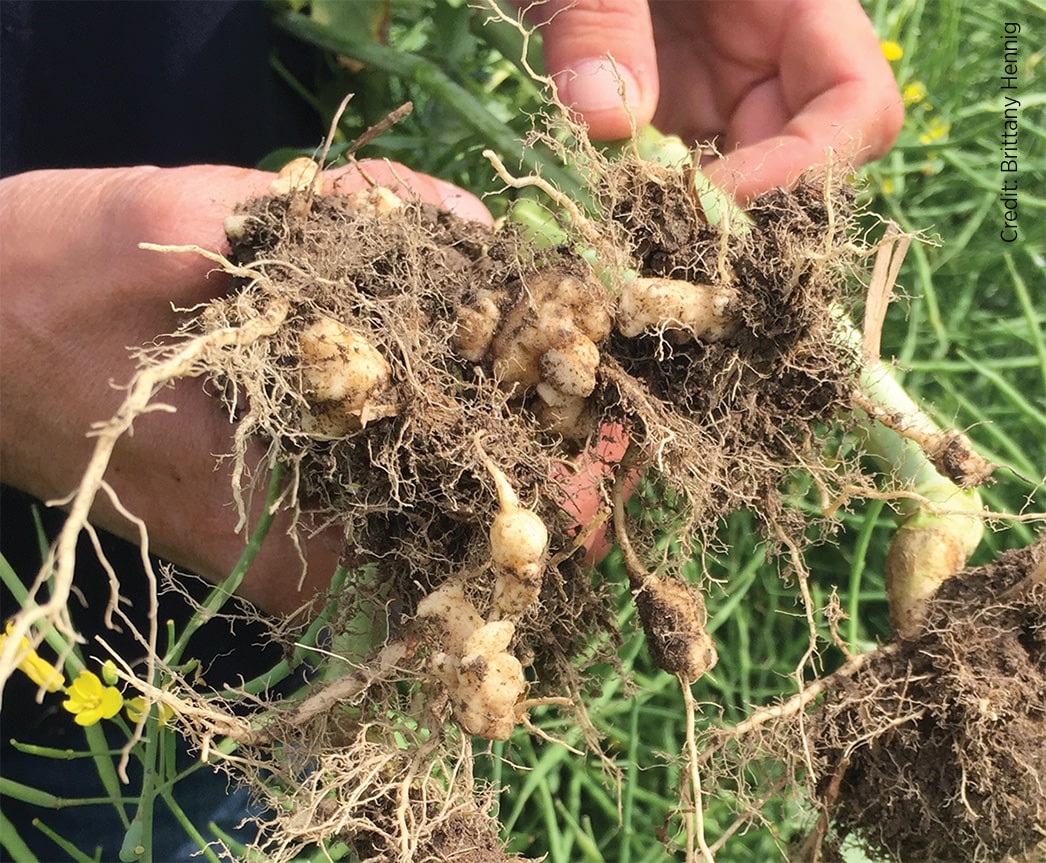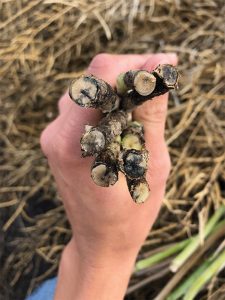Agronomy Insights
What clubroot-resistant seed will you grow in 2020?
Clubroot-resistant (CR) varieties should be grown before the disease becomes established in your area. Is your area at risk? Yes. That’s the safe assumption as clubroot continues to show up in new areas throughout the Prairies.
We want growers to use CR varieties before clubroot arrives on a field because the pathogen, once detected, will already have a leg up on any future management strategies. CR varieties used early will keep spore loads low and local, particularly if combined (and this is important) with at least a two-year break between canola crops and an absolute minimum amount of soil movement. See the full recipe below.
Canola growers already using CR varieties may want to pick new varieties next year, given that repeat use of the same CR source will select for pathotypes not controlled by the resistant genes in that CR source. Many fields across the Prairies had galls form on CR varieties in 2019.
Here’s how that happens: One clubroot gall produces millions to billions of resting spores and that population of spores can contain multiple Plasmodiophora brassicae pathotypes. However, one or two pathotypes tend to be dominant across a field, with other pathotypes present only at low levels. First generation CR varieties are resistant to the most common pathotypes across the Prairies. Natural selection can occur with repeated use of the same type of resistance, which will keep the common pathotypes from increasing but opens the door for rapid increases of some less common pathotypes that were present in the field at low levels. Over time, these less common pathotypes could become the new dominant pathotypes in the population. This is the “selection pressure” that makes natural selection work on clubroot. Through repeated use of the same resistance sources (especially in short rotations), you select for the pathotypes that can overcome the resistance used.
Recipe for clubroot management
When combined, like ingredients in a recipe, the following practices will help growers to limit clubroot damage in canola, allowing for the continued success and profitability of canola production across the Prairies.
- Vigilantly scout all canola fields for symptoms, even if growing a CR variety.
- Keep a minimum two-year break between canola crops. This crop rotation is crucial in the stewardship of genetic resistance. With a two-year break between clubroot hosts, we see a rapid decline in living resting spores.
- Seed CR varieties and understand if/when to deploy different sources of CR. As noted above, planting CR varieties before the disease arrives and gets established will give you a better chance of keeping the resting spore load at a manageable level and maintaining effective resistance. Rotation of resistance genes is important to maintain resistance efficacy.
- Limit soil movement and erosion. Minimum tillage and equipment sanitation (as simple as knocking off visible dirt before leaving a field) will greatly reduce the risk of moving infested soil around.
Wet soil conditions increase the amount of soil that clings to equipment. - Control host weeds. Common weeds that can host clubroot include stinkweed, shepherd’s purse, flixweed, all mustards and volunteer canola. They need to be controlled within three weeks of emergence to prevent a new batch of spores being produced.
- Isolate highly infested patches. Patches that are visibly worse than the remainder of your field often have billions more spores per gram of soil than elsewhere and are often the first place where clubroot resistance breaks down. Seeding these areas down to grasses and taking them out of production for a few years will significantly reduce the risk of spread and resistance breakdown. As part of this, having separate field entrances and exits could reduce the amount of infested soil leaving the field on machinery.
Still time (maybe) to register for Canola Discovery Forum
 Canola Discovery Forum 2019 is November 13-14 at the RBC Convention Centre in Winnipeg, Manitoba. Growers, agronomists, researchers and any other interested stakeholders are welcome to attend – if space is still available. The forum is all about consensus-building and dialogue on best practices for canola productivity and profitability. The theme this year is integrated pest management. For more information and to register, go to canoladiscoveryforum.ca. Look for forum findings in Canola Watch and an upcoming Canola Digest.
Canola Discovery Forum 2019 is November 13-14 at the RBC Convention Centre in Winnipeg, Manitoba. Growers, agronomists, researchers and any other interested stakeholders are welcome to attend – if space is still available. The forum is all about consensus-building and dialogue on best practices for canola productivity and profitability. The theme this year is integrated pest management. For more information and to register, go to canoladiscoveryforum.ca. Look for forum findings in Canola Watch and an upcoming Canola Digest.
Compare varieties at canolaperformancetrials.ca
Enhance your 2020 seed decision making with the searchable online database of grower-funded variety trials. Results from across Western Canada from the past eight years are posted, and 2019 results will be loaded once available. Go to canolaperformancetrials.ca and use the ‘Search Performance Trial Results’ tool at the bottom of the main page.
November soil tests for clubroot
November is not too late to collect soil for a clubroot pathogen DNA test. A soil test of high risk areas can indicate the presence of the clubroot pathogen before symptoms show up in canola plants. These early-stage results give farmers a chance to put a CR variety on that field early and implement the other ingredients in the clubroot management recipe before spore levels get out of hand.
Labs need approximately two to three cups of soil for a test. Collect a composite sample taken in a “W” pattern near the major approach or entrance to the field, or other high clubroot risk areas in the field, including low areas. Sample soil from the top five to 10 cm, excluding as much surface organic matter as possible. Note however that clubroot DNA can be introduced in very small areas within a field, and soil collection may not hit those exact locations. Consider this before putting 100 per cent faith in the result.
Saskatchewan Ministry of Agriculture has two helpful factsheets “Clubroot soil sampling on the Prairies” and “Interpreting a clubroot soil test result”. Look for them at saskatchewan.ca. For the list of labs that will check soil for clubroot DNA, look under the ‘Identify clubroot’ heading at clubroot.ca.
Do you need to change blackleg resistance for 2020?

If the weather cooperates, canola growers and agronomists may still have an opportunity to collect stubble pieces for detection and identification of the blackleg pathogen, L. maculans. If you had a little too much blackleg infection in canola this year, the dominant races of L. maculans in the field may be overcoming the current choice of blackleg resistance deployed. Labs can test infected stubble pieces to see what races are present, including older stem pieces from fields planned for canola in 2020. Growers can use this information to choose varieties with a major genes that aligns with (and provides resistance against) the most common races identified in those samples.
Even if a hybrid has a stack of major resistance genes and good support from quantitative resistance, varieties are not resistant to all races. Growing the ‘best’ resistant varieties over and over will select for races that can overcome this resistance. (Read more in the ‘Genetic resistance’ chapter at blackleg.ca.) Resistant varieties are just one tool to help manage the disease. Proper crop rotation and early identification of the disease are other important steps.
Read Canola Watch. Improve your profitability
The Canola Council of Canada agronomy team, with support from the provincial canola organizations, bring you Canola Watch – a timely yield- and profit-enhancing resource. The weekly email gives you an early warning on emerging threats to production and provides timely management tips for agronomy challenges throughout the growing season. Sign up for free at canolawatch.org/signup. You can also follow @CanolaWatch on Twitter.
Get to know your Canola Council of Canada agronomy team.
Find the roster and interactive map at canolacouncil.org.





